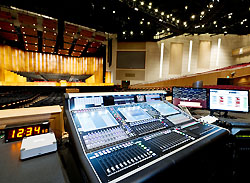
The new BYU-Idaho Center at Brigham Young University-Idaho, is a sprawling 435,000-square-foot building that includes a 15,000-seat auditorium outfitted with two DiGiCo two SD7 digital mixing systems as well as six DiGiRacks.
The process to outfit the venue with an audio/visual system took roughly three years from conception to completion, spearheaded by senior project engineer Andrew Prager of New Jersey’s Diversified Systems with the aid of BYU-Idaho audio engineer David Mann.
As a representative of the venue and its principals, Mann’s number one design criterion for the system was overall speech intelligibility. “Because this is primarily a worship facility,” he explains, “the spoken word is the reason the facility exists and was of utmost importance to everyone involved.”
Armed with that missive, Prager identified the scope of the system and its components, which included a front end and monitor mixer, digital signal processing, amplifiers, and loudspeakers.
As for the mixer specifically, it needed enough inputs/outputs to be shared between both the front of house and monitor mix consoles. Additionally, it needed to be digital and fiber-optic based. The sale comprised the two SD7s and six DiGiRacks—one dedicated to each console at front of house and monitors, with four shared between the two.
Having a fiber optic-based system was also top priority with a majority of advantages—price notwithstanding—including latency and speed. “It’s very cost effective to run fiber,” states Mann. “Obviously, the cost benefit of fiber is much more budget-friendly, but also the amount of information you can send via fiber optics is incredible.”
“The things that come to my mind when we’re talking about digital audio traveling as light instead of through copper is that it’s faster in terms of latency,” Prager adds. “It gives us a smaller cable pathway rather than big fat copper hoses running around the place, and there is a built-in immunity to grounding problems, which can be caused from different power ground and sources.
“We have a third party digital audio transport system running MADI over Opticore—a dual ring of fiber that goes between the mixer and the DiGiCo stage racks. It’s a very robust, very redundant system and because it’s a ring there’s a connection of fiber and the signal can just come from one way or go the other. “
The consoles are being put through a rigorous pace since their installation, on events ranging from BYU-Idaho’s on-going weekly Tuesday devotional service to a small number of musical and theatrical productions.
“Both the events and the Tuesday services range in size and scope,” says Mann. “The Tuesday service, with its single talking-head presenter, also showcases a special musical number, which ranges from a soloist with piano accompaniment to a 350-voice choir with orchestra. Depending on the week, it can be very simple or very demanding. On our typical devotional, we’re running approximately 6-8 inputs; on an elaborate one, it’s more like 80.”
Perhaps one of BYU-Idaho’s most elaborate events was the “Savior of the World” production performed in March, involving an 80-piece orchestra and a 230-voice choir. The input list alone was staggering—in the high 80s—40 of which were to accommodate wireless mics.
Coming from a live sound background, Mann says the challenges of the worship environment are very much different. “When you’re working with a band and vocalists, you generally get a good strong sound coming into your console so you have something solid to work with. In a worship environment, dealing with a single speaker on stage, especially in a podium-type situation, you don’t always get a great level and so it’s a challenge to get enough signal before it starts to feedback. That’s my main challenge in this environment. I think I would rather mix a 300-voice choir and 80-piece orchestra any day over a single voice speaker.”
